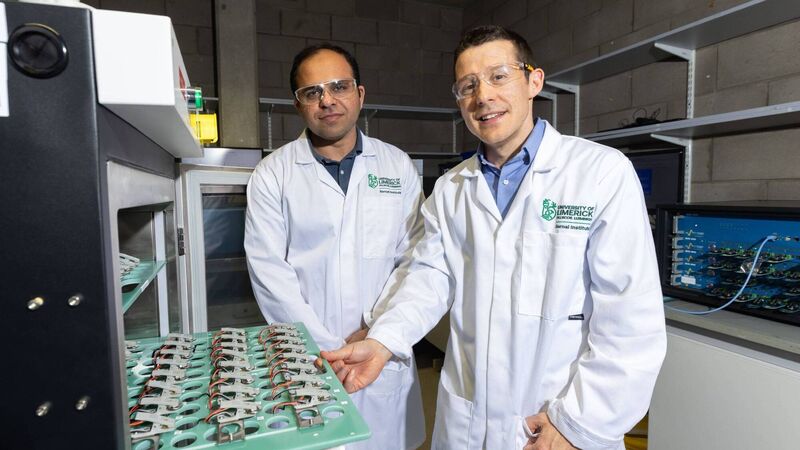UL scientists create world’s first dual-cation battery, setting new benchmark for sustainable energy storage

Associate Professor Hugh Geaney(right) and Government of Ireland postdoctoral fellow Dr Syed Abdul Ahad, pictured in the Bernal Institute at University of Limerick where they have developed world’s first full-cell dual cation battery. Picture: Alan Place
Researchers at the University of Limerick (UL) have developed the world’s first full-cell dual-cation battery, a major breakthrough in energy storage technology.
This innovative system combines lithium and sodium ions to significantly improve both battery capacity and stability, marking a new milestone in sustainable energy research.
Published in , the study was led by Professor Hugh Geaney, Associate Professor of Chemistry at UL’s Department of Chemical Sciences and Principal Investigator at UL’s Bernal Institute, and Dr Syed Abdul Ahad, a Government of Ireland postdoctoral fellow and his colleague at the Department and the Bernal Institute.
The project was conducted in collaboration with researchers at the University of Birmingham.
Unlike traditional sodium-only (single-cation) batteries, this new dual-cation system combines the strengths of both lithium and sodium to deliver superior performance while maintaining sodium as the primary component, making the technology more efficient and sustainable.
Professor Geaney said: "For the first time, we’ve shown that sodium-ion batteries can be ‘supercharged’ by pairing sodium and lithium in a sodium-dominant dual-cation electrolyte".
Dr Abdul Ahad, who conceptualised and carried out the experimental work under Professor Geaney’s guidance, said: "This approach not only improves energy density—critical for extending the range of electric vehicles—but also enhances safety and sustainability by reducing reliance on costly and environmentally challenging materials like cobalt."
Sodium-ion batteries have long been seen as a more sustainable alternative to lithium-ion batteries, which currently power most commercial devices.
However, sodium-ion batteries typically lack the same energy density as lithium-ion cells, leading to poorer performance.
This new development means sodium ions can now deliver high capacity without sacrificing sustainability.
The lithium and sodium ions work together during charging and discharging, and the cell can be cycled up to 1,000 times, creating a greener and more cost-effective battery.
The research was supported by the Government of Ireland Postdoctoral Fellowship and Science Foundation Ireland’s Frontiers for the Future programme.
The team now plans to expand the study to explore new material combinations and ion systems, including silicon-based anodes and alternative pairings such as lithium-magnesium and potassium-lithium.













